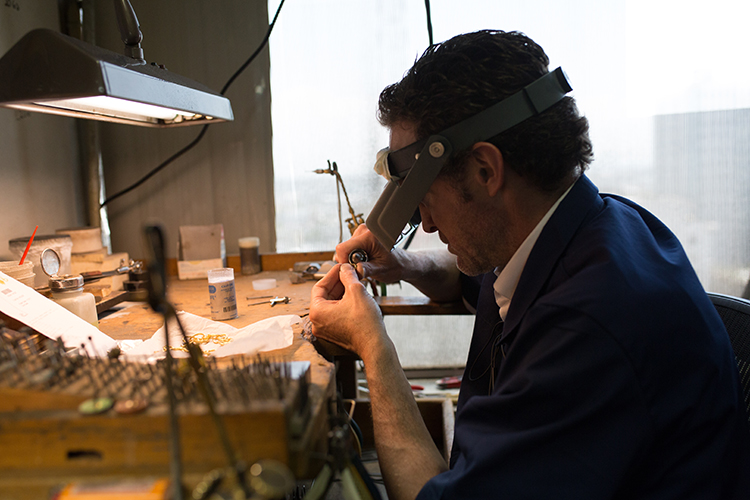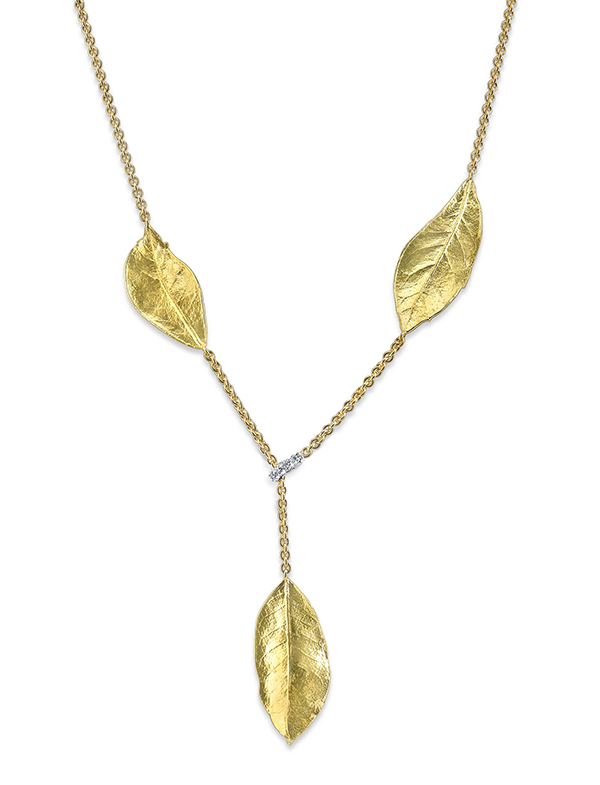Writer Amanda Christmann
Photography by Doug McNamee
[dropcap]I[/dropcap]n a small studio in downtown Los Angeles’ Jewelry District, Aaron Furlong and his father Conrad are perched on benches a few feet apart, rapt in their work. Wearing pale blue aprons and magnification visors, they both hunch over their projects, with only the taps and brushing of hand tools breaking the silence.
It’s a routine the pair has worn like a favorite sweater. For nearly three decades, they’ve worked alongside each other, creating beautiful jewelry and carrying on a tradition that began nearly a century ago with a Russian orphan and a dream.
In the first decades of the 20th century, Aaron’s grandfather, Anthony Kantor, was just a small boy when his family was killed in the pogroms on the streets of Russia. Over the next years, he managed to flee through Manchuria in northeast China, and was adopted by a family who brought him to the United States.
Once in the U.S., Kantor met an Air Force pilot who had a particular interest in diamonds. As a very poor child, Kantor had only dreamed of the riches of diamonds and gems he’d seen among the elite. Hard-working and determined, he began working with suppliers to import diamonds into the U.S.
Kantor applied the same perseverance that had gotten him through the ethnic cleansing in Russia to his work with diamonds, and his handshake was as binding as a contract.
“He started our family into the jewelry business,” his grandson, Aaron Furlong, says. “He became a very successful diamond merchant.”
Kantor’s code of ethics was unequivocal, and he became more than just successful. He was a pioneer, and a pillar of the Los Angeles diamond industry.
Decades later, there was another young man who showed promise in the jewelry industry: Conrad Furlong. Kantor’s daughter, Irene, had taken an interest in the young man, and Kantor took a liking to him.
The Second Generation
“My father was a shoe salesman,” Aaron says of Conrad. “My grandmother saw him working with a model and told him he had very good hands—that he should be a diamond setter.”
At that time, the diamond industry could only be taught through family lineage, specifically to sons and sons-in-law. It was a tight-knit community, but Aaron’s grandfather leveraged some of his industry friendships to get Conrad an internship.
Though the introduction helped, Conrad had to work hard to prove himself. As an apprentice, he was not allowed to touch gold or gems, or speak to the setters.
He took it in stride, watching over their shoulders, then heading home at the end of each long day to a makeshift workbench he’d built in his small apartment. He used fake stones and mountings and his remarkable memory to reproduce all he’d seen.
Eventually, he built his own shop and employed about 40 craftsmen, creating jewelry for other designers. He married Irene, had a son, and built his business upon the same personal standards that his father-in-law believed in.
Yet he became frustrated.
“He noticed that he was the first in, the last out, and that he was the least paid,” says Aaron. “He kept five of his best guys moved into a smaller shop.”
Conrad Furlong’s new shop was on the renowned Hill Street, where he focused on high line design, creation and setting for Cartier, Tiffany and other high-end purveyors. Irene took on the bookkeeping, a role she enjoyed until she passed away five years ago.
The Third Generation
Young Aaron grew up around the jewelry business.
“I would go down and play with pearls in my grandfather’s office,” he says with a smile.
“In my father’s office, I would help separate burrs, which are used for grinding, shaping and drilling. I’d separate the ones that still had life in them from the ones that had to be thrown out. It was all part of my childhood.”
Though he’d grown up surrounded by jewelry, Aaron had to take his own path to discover his love for it.
“In 1990, I completed my degree in psychology,” he explains. “I spent a year at a suicide prevention hotline, and I realized that I didn’t want the rest of my life to go that way. I sat down and thought about what I wanted to do next.”
He returned home, spoke to his father, and completed his Graduate Gemologist degree from the Gemological Institute of America, where he also learned basic goldsmithing techniques.
Aaron began working under Victorino Garcia, a renowned jeweler who had been named the personal jeweler to Imelda and Ferdinand Marcos before they were ousted from leadership of the Philippines.
“He taught me and gave me small jobs until I’d learned enough to develop my own style and skill,” Aaron says. “I launched my own line in 1999.”
Aaron Furlong’s decision to return to the family business has proven to be wise. Today, he is the founder of Aaron Henry, a small but prestigious jewelry design and manufacturing company that has already left its indelible mark in jewelry design. Aaron is a goldsmith, while Conrad does most of the natural gemstone setting.
Aaron Henry designs have been used in marketing for World Gold Council, California Jewelers Association, Gemological Institute of America and diamond giant DeBeers, and he has won numerous prestigious industry awards.
Their work has also appeared in Vanity Fair, Town & Country, Forbes, Millionaire and InStyle magazines, and Jewelers Quarterly magazine tapped him as Designer of the 21st Century. He is president of the Association of Professional Jewelry Designers’ Contemporary Design Group.
The Beauty of Slowing Down
Generational threads have woven their way into Aaron Furlong’s life, and into Aaron Henry.
Like his grandfather and father before him, Aaron Furlong is all about excellence, even if it takes time.
“I fabricate jewelry with torches, drills and hand tools,” he says. “We have a small shop, but we have an outstanding attention to detail and create very high-end designs. We cast our own metal and alloy our own gold.”
“We only make a couple of hundred pieces a year, and they’re all limited edition and higher end.”
His design inspiration has also not fallen far from the tree of history. In fact, one could say trees are his muses.
Just as his grandfather once crossed Manchuria primarily by foot, both Conrad and Aaron have taken to hiking. In fact, they still enjoy finding hidden trails together when they can.
Their encounters in the wild are often the source of Aaron Henry design genius.
“In 1998, I went backpacking with my dad,” Aaron explains. “It was October, and a mile or two into the trail, all of these trees were changing colors. It was beautiful. I began picking up little things and putting them in a Ziploc bag. Those things became the basis for a lot of the leaf pieces I’ve created since then.”
Tiny, intricate leaves, flowers and other organic elements have become an Aaron Henry trademark.
“As I’ve traveled the last two decades, I’ve picked up maple leaves in Washington State, magnolias from the South, gingkoes from upstate New York and birch leaves in Ohio.
“In Louisiana, we found huge Southern oak trees that were just amazing. I started picking up samples, and I brought them back to the studio. That’s where a lot of the acorns I use in my designs came from.
“We have olive trees in our front yard, and I find myself using a lot of olive branches inspired by those trees. I love the symbolism.”
Some of Aaron’s designs come from ideas collected much farther away.
“Whether I’m traveling and seeing different motifs on the temples in Cambodia or the mosaics in Florence, there is so much all around in plants and flowers to be inspired by.
“I’ve got a box of a lot of things that I go back to often for ideas. For every design that I’ve made, there are probably seven or eight that didn’t make it that far, but each one has led me to another break in the road—another idea. Sometimes I will come back to one of those pieces five years later and I’ll look at it in an entirely different way.
“Nothing’s ever worthless. Sometimes it’s just not the right time.”
Like his father and grandfather before him, Aaron finds great satisfaction in spending hours at his workbench creating beauty from nature’s most raw but valuable elements.
“The stones I like to use are variegated in color—they’re not all the same. It makes for a more interesting, more organic look. If you look at anything in nature, it’s not all one color. That’s just how it occurs in nature, and that’s what I try to emulate.
He points to a beautiful spectrum of blues in a cluster ring.
“They’re beautiful,” he says, his eyes beaming. “They’re like a flower that never dies.”
Spinels, moonstones, morganite, sapphires, and other beautiful stones have all become part of Aaron Henry jewelry. Over time, the family designs have evolved. Today, buyers embrace a decidedly contemporary element to the jewelry.
“I would describe our design style as organic, and understated but elegant,” Aaron explains. “I try to make jewelry that you can dress up or dress down, and that can be worn with a white t-shirt and jeans, or worn with a black dress.
“Of course, we do make some that are more fancy, but overall, Aaron Henry jewelry is very wearable across the spectrum.”
Locally, Aaron Henry designs have found a new audience at Grace Renee Gallery in Carefree. Aaron and Conrad Furlong will host a wine reception to feature some of their brilliant, hand-crafted contemporary jewelry.
Between now and then, the two can be found hard at work in the shop, as they are today.
It would appear that, like his grandfather and father, creating jewelry has always been Aaron’s destiny.
“I put on headphones and a magnification visor, then tune everything out,” he says. “I focus on what’s in front of me. It’s almost meditative. The hours just pass by.”
Aaron Henry: An American Luxury Collection
Nov. 22, 23 | 10 a.m.–8 p.m. Friday; 10 a.m.–6 p.m. Saturday | Wine and appetizers Friday 4–8 p.m. | Grace Renee Gallery | Historic Spanish Village
7212 E. Ho Hum Rd. #7, Carefree | 480-575-8080 | gracereneegallery.com









Comments by Admin